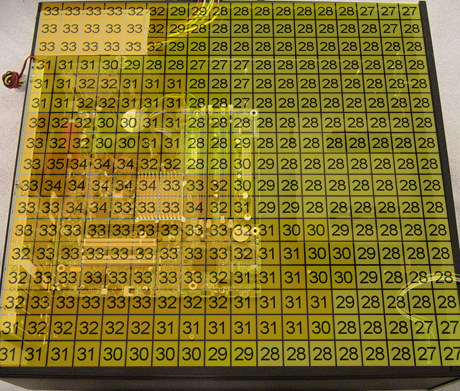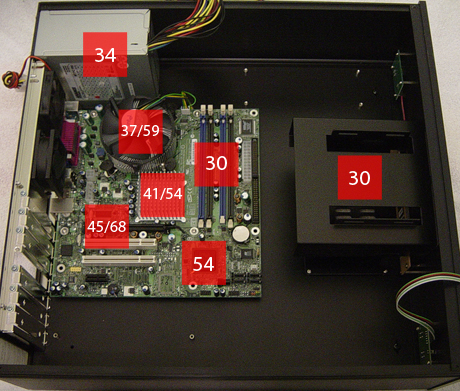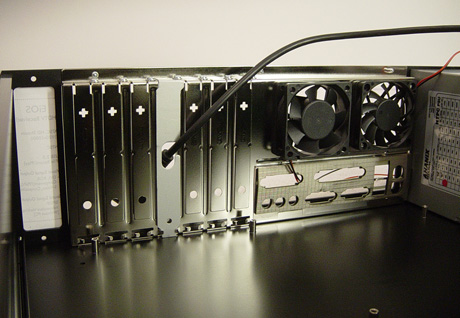Intel's Long Awaited BTX Form Factor
by Purav Sanghani on November 15, 2004 5:31 AM EST- Posted in
- Cases/Cooling/PSUs
Thermals Desktop ATX
We tested our D915GUX board and Pentium 550 CPU in Ahanix's D.Vine 5 HTPC chassis, the successor to the D.Vine 4 we reviewed last month, since it had the size of a typical mid tower case yet took on the form of a flat lying desktop case like the B300 to give a better idea of how this hardware performed in a case with sizes we are used to. Unlike Opus Technologies, Ahanix has a great deal of products, many of them cases which is their main focus. The first case we reviewed from Ahanix was their Black Knight. The Black Knight performed well in our thermal benchmarks while averaging at 50dBA in sound We again measure temperatures of the ambient air inch by inch to show how each component affects various areas of the case.
Click to Enlarge
It is evident that the warmest region in our desktop ATX system is between the CPU, Northbridge, and PCIe VGA card followed by the power supply. We also notice how the rear exhaust fans are pulling the warm air towards them to the outside. The D.Vine 5 has an extremely large footprint, 17" in width by 18" in depth, so there are many areas which are not being exposed to warm air such as the front corners as well as the left side of the case.

Click to Enlarge
We see here that the CPU, Northbridge heatsink and the PCIe VGA card are the hottest components in the system. The Southbridge also ran extremely hot at 54 degrees, but it is too small to have as great of an effect on the ambient air around it as did the other three. The power supply, on the other hand, measured to be 34 degrees which had a great affect on its surrounding air.

Click to Enlarge
Again, since the D.Vine 5 lies flat instead of upright like the TT-501 does, heat pockets mainly occur over the equipment giving off the heat instead of at the top of the case (the right side in this case) near the power supply.










77 Comments
View All Comments
L3p3rM355i4h - Thursday, February 10, 2005 - link
Seems to be good for the OEM market, but what about us people who *actually* care about computers? Front exhuaust has to be the stupidest thing ever. Why was it so hard just to reverse the layout, so it would be atleast somewhat compatable with the current ATX standard.And the guy/gal who made up the "ATX II" standard, maybe you should contact AMD or someone. They might be interested.
EthernaL - Friday, May 19, 2006 - link
What if I really LIKE my BIG ATX tower?Maybe I have temperature problems in summer... maybe is not all the efficient that could be but I really love this design and I don't want to move to a small design and I don't want to buy the whole thing again.
Another nice thing with the computers we currently have is the possibility to give our friends/relatives old pieces once we upgrade our computer (my sister's computer is build that way :P )
So, again, another decission based ONLY on money without thinking in what we (the users) want or need. Thanks Intel, I hate you more than ever, and if you 'force us' to move to that technology I hope your business will go bankrupt.
IntelUser2000 - Sunday, November 21, 2004 - link
"From the picture we see the flow of air pushed back through the CPU thermal module towards the Northbridge, Southbridge, and VGA card. As this air flows around the CPU, it warms up, as we can see from the red areas to the left and right of the CPU. This warm air then flows over the Northbridge and seems to cool as it travels further back in the chassis. At the left we see the channel of air flowing to the left over the memory and out through the PSU. The channel on the right flows straight back to the VGA card and out through groups of holes in the back of the case."Well doesn't look like to me that hot air comes out front.
MadAd - Friday, November 19, 2004 - link
One question im having in my mind is how big of a paintbrush will i need to get inbetween those fins - talk about a dust trap.At least a majority of atx heatsink designs have easy to clean fins, and boy do they need cleaning sometimes, this is going to be worse.
Cue the repair calls in years to come, $50 an hour for removing wads of the customers cat/dog/children from around the cooler after the safety backoff system renders the machine temporatily gonadless.
epiv - Thursday, November 18, 2004 - link
Intel can and should make BTX backward and forward compeitable with ATX so we can decide if a new BTX case and PSU is worth the money.I am a poor student and I already spend money on a good case and PSU. My case should be able to handle more heat than a regular BTX case. I really hope I will not have to get a new case and PSU when I upgrade my computer.
trikster2 - Wednesday, November 17, 2004 - link
facts? I actually own the silverstone version of the oppus case, so I am actually speaking from experience. Vertical vs horizontal lowprofile vs full height has a lot to do with heat disapation
Myrandex - Tuesday, November 16, 2004 - link
I wonder how BTX had a NDA because Gateway has been selling BTX computers at best buy for over a month at leastCygni - Tuesday, November 16, 2004 - link
Dont you bring facts into this, Kris! Trikster2 doesnt want any of that!KristopherKubicki - Tuesday, November 16, 2004 - link
trikster2: The Opus case was chosen because it was the same volume as the mBTX case. I don't really see how a mATX tower and an mBTX case are going to differ significantly.Kristopher
ceefka - Tuesday, November 16, 2004 - link
How can this possibly translate into lower cost for end users? Thank you, Intel.I am also disappointed by Intel's approach. Uhm, we have a hot CPU; let's make a cooler case!
Since they invented this in their own backyard without creating a wide support it looks like an ego-trip.